
Helicinidae is a family of small tropical land snails which have an operculum. They are terrestrial operculate gastropod mollusks in the superfamily Helicinoidea.
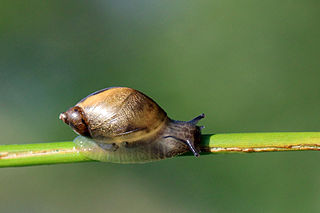
Succinea, common name the amber snails, is a large genus of small, air-breathing land snails, terrestrial pulmonate gastropod molluscs in the family Succineidae.

Helicidae is a large, diverse family of small to large, air-breathing land snails, sometimes called the "typical snails."

Aaadonta is a genus of air-breathing land snails, terrestrial pulmonate gastropod mollusks in the family Endodontidae. Specimens from this genus are endemic to Palau.

Vertiginidae, common name the whorl snails, is a family of minute, air-breathing land snails, terrestrial pulmonate gastropod molluscs or micromollusks in the superfamily Pupilloidea.

Clausiliidae, also known by their common name the door snails, are a taxonomic family of small, very elongate, mostly left-handed, air-breathing land snails, sinistral terrestrial pulmonate gastropod mollusks.
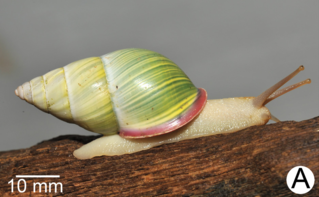
Amphidromus is a genus of tropical air-breathing land snails, terrestrial pulmonate gastropod mollusks in the family Camaenidae. The shells of Amphidromus are relatively large, from 25 mm (0.98 in) to 75 mm (3.0 in) in maximum dimension, and particularly colorful. During the 18th century, they were among the first Indonesian land snail shells brought to Europe by travelers and explorers. Since then, the genus has been extensively studied: several comprehensive monographs and catalogs were authored by naturalists and zoologists during the time period from the early 19th to the mid 20th centuries. Modern studies have focused on better understanding the evolutionary relationships within the group, as well as solving taxonomic problems.

A land snail is any of the numerous species of snail that live on land, as opposed to the sea snails and freshwater snails. Land snail is the common name for terrestrial gastropod mollusks that have shells. However, it is not always easy to say which species are terrestrial, because some are more or less amphibious between land and fresh water, and others are relatively amphibious between land and salt water.
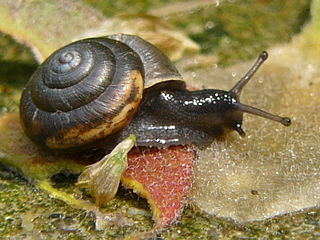
Hygromiidae is a taxonomic family of small to medium-sized air-breathing land snails, terrestrial pulmonate gastropod mollusks in the superfamily Helicoidea.

Camaenidae is a family of air-breathing land snails, terrestrial pulmonate gastropod mollusks in the superfamily Helicoidea, the typical snails and their allies. This is one of the most diverse families in the clade Stylommatophora.

Euglandina is a genus of predatory medium- to large-sized, air-breathing, land snails, terrestrial pulmonate gastropod mollusks in the family Spiraxidae.
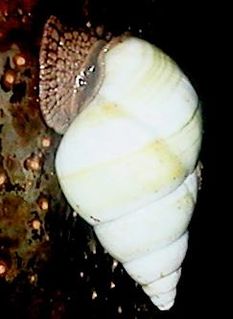
Liguus is a genus of large tropical air-breathing land snails, more specifically arboreal or tree snails, terrestrial pulmonate gastropod mollusks in the family Orthalicidae.
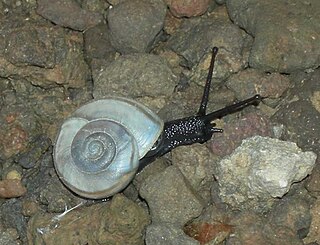
The Helminthoglyptinae are a subfamily of air-breathing land snails, terrestrial pulmonate gastropod mollusks within the family Xanthonychidae.

Cepolidae is a family of air-breathing land snails, terrestrial pulmonate gastropod mollusks in the superfamily Helicoidea.

Spiraxidae is a family of predatory air-breathing land snails, terrestrial pulmonate gastropods in the superfamily Testacelloidea.
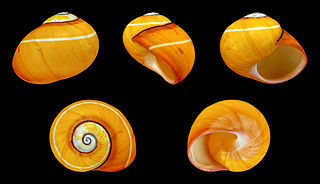
Polymita picta, common name the Cuban Painted Snail,or The Oriente Tree Snail, is a species of large, air-breathing land snail, a terrestrial pulmonate gastropod mollusk in the family Helminthoglyptidae.
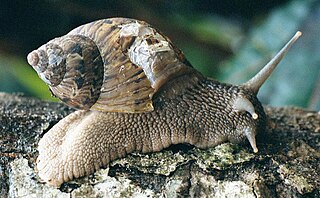
Sultana is a genus of air-breathing land snails, terrestrial pulmonate gastropod mollusks in the family Orthalicidae.

Freshwater snails are gastropod mollusks which live in fresh water. There are many different families. They are found throughout the world in various habitats, ranging from ephemeral pools to the largest lakes, and from small seeps and springs to major rivers. The great majority of freshwater gastropods have a shell, with very few exceptions. Some groups of snails that live in freshwater respire using gills, whereas other groups need to reach the surface to breathe air. In addition, some are amphibious and have both gills and a lung. Most feed on algae, but many are detritivores and some are filter feeders.

Quantula striata, also known as Dyakia striata, is a species of medium-sized, air-breathing, tropical land snail. It is a terrestrial, pulmonate, gastropod mollusk in the family Dyakiidae. This species appears to be unique among terrestrial gastropods in that it is bioluminescent: Its eggs glow in the dark, and juveniles and most adults give off flashes of green light. It is the only species in the genus Quantula.



















